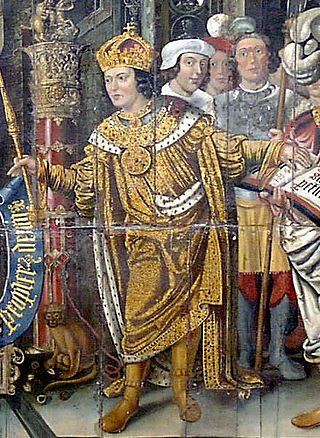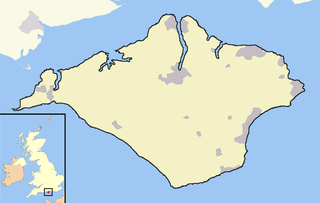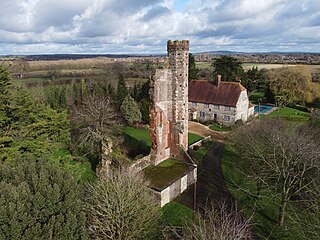
Ceawlin was a King of Wessex. He may have been the son of Cynric of Wessex and the grandson of Cerdic of Wessex, whom the Anglo-Saxon Chronicle represents as the leader of the first group of Saxons to come to the land which later became Wessex. Ceawlin was active during the last years of the Anglo-Saxon expansion, with little of southern England remaining in the control of the native Britons by the time of his death.

Emsworth is a town in the Borough of Havant in the county of Hampshire, on the south coast of England near the border with West Sussex. It lies at the north end of an arm of Chichester Harbour, a large and shallow inlet from the English Channel, and is equidistant between Portsmouth and Chichester.

Hampshire is a ceremonial county in South East England. It is bordered by Berkshire to the north, Surrey and West Sussex to the east, the Isle of Wight across the Solent to the south, Dorset to the west, and Wiltshire to the north-west. The cities of Portsmouth and Southampton are the largest settlements and the county town is the city of Winchester.

The Jutes were one of the Germanic tribes who settled in Great Britain after the departure of the Romans. According to Bede, they were one of the three most powerful Germanic nations, along with the Angles and the Saxons:
Those who came over were of the three most powerful nations of Germany—Saxons, Angles, and Jutes. From the Jutes are descended the people of Kent, and of the Isle of Wight, and those also in the province of the West Saxons who are to this day called Jutes, seated opposite to the Isle of Wight.

The Kingdom of the South Saxons, today referred to as the Kingdom of Sussex, was one of the seven traditional kingdoms of the Heptarchy of Anglo-Saxon England. On the south coast of the island of Great Britain, it was originally a sixth-century Saxon colony and later an independent kingdom. The kingdom remains one of the least known of the Anglo-Saxon polities, with no surviving king-list, several local rulers and less centralisation than other Anglo-Saxon kingdoms. The South Saxons were ruled by the kings of Sussex until the country was annexed by Wessex, probably in 827, in the aftermath of the Battle of Ellendun. In 860 Sussex was ruled by the kings of Wessex, and by 927 all remaining Anglo-Saxon kingdoms were ruled by them as part of the new kingdom of England.

Cerdic is described in the Anglo-Saxon Chronicle as a leader of the Anglo-Saxon settlement of Britain, being the founder and first king of Wessex, reigning from around 519 to 534 AD. Subsequent kings of Wessex were each claimed by the Chronicle to descend in some manner from Cerdic. His origin, ethnicity, and even his very existence have been extensively disputed. However, though claimed as the founder of Wessex by later West Saxon kings, he would have been known to contemporaries as king of the Gewissae, a folk or tribal group. The first king of the Gewissae to call himself 'King of the West Saxons', was Cædwalla, in a charter of 686.

Havant is a town in the south-east corner of Hampshire, England between Portsmouth and Chichester. Its borough comprises the town (45,826) and its suburbs including the resort of Hayling Island as well as Rowland's Castle, the larger town of Waterlooville and Langstone Harbour. Housing and population more than doubled in the 20 years following World War II, a period of major conversion of land from agriculture and woodland to housing across the region following the incendiary bombing of Portsmouth and the Blitz.

Carisbrooke Castle is a historic motte-and-bailey castle located in the village of Carisbrooke, Isle of Wight, England. Charles I was imprisoned at the castle in the months prior to his trial.

Cædwalla was the King of Wessex from approximately 685 until he abdicated in 688. His name is derived from the Welsh Cadwallon. He was exiled from Wessex as a youth and during this period gathered forces and attacked the South Saxons, killing their king, Æthelwealh, in what is now Sussex. Cædwalla was unable to hold the South Saxon territory, however, and was driven out by Æthelwealh's ealdormen. In either 685 or 686, he became King of Wessex. He may have been involved in suppressing rival dynasties at this time, as an early source records that Wessex was ruled by underkings until Cædwalla.
Cenwalh, also Cenwealh or Coenwalh, was King of Wessex from c. 642 to c. 645 and from c. 648 until his death, according to the Anglo-Saxon Chronicle, in c. 672.

Hampshire is a county in Southern England with some notable archaeology and many notable historic buildings.

The Isle of Wight is rich in historical and archaeological sites, from prehistoric fossil beds with dinosaur remains, to dwellings and artefacts dating back to the Bronze Age, Iron Age, and Roman periods.

Æthelwealh was ruler of the ancient South Saxon kingdom from before 674 till his death between 680 and 685. He was baptised in Mercia, becoming the first Christian king of Sussex. He was killed by a West Saxon prince, Cædwalla, who eventually became king of Wessex.

Westbourne is a village, civil parish and electoral ward in the Chichester District of West Sussex, England. It is located 0.5 miles (0.80 km) north east of Emsworth. The parish includes the hamlets of Woodmancote and Aldsworth, and once included the settlements of Southbourne and Prinsted to the south.

The River Ems is a much-sluiced, six miles (9.7 km) river that is located in the far west of the county of West Sussex, England.The last one and a half miles (2.4 km), of this river, delimits eastern Hampshire, before flowing into the sea at Chichester Harbour.

Wihtwara was the kingdom founded on the Isle of Wight, a 147-square-mile (380 km2) island off the south coast of England, during the Anglo-Saxon settlement of Britain. The name was derived from the Jutish name Wihtwara. Its capital was a fort named Wihtwarasburgh. It has been suggested that the modern-day village of Carisbrooke was built on top of Wihtwarasburgh due to the fact that they share their location. It has also been suggested that Wihtwarasburgh was built on top of a pre-existing Roman fort, but this has not been proven.
The Meonwara were one of the tribes of Anglo-Saxon Britain. Their territory was a folkland located in the valley of the River Meon in Hampshire that was subsumed by the Kingdom of Wessex in the late seventh century.

Warblington Castle or Warblington manor was a moated manor near Langstone in Havant parish, Hampshire. Most of the castle was destroyed during the English Civil War, leaving only a single gate tower, part of a wall, and a gateway. The property, now in the village of Warblington, is privately owned and does not allow for public access.

St Thomas à Becket Church, sometimes referred to as St Thomas of Canterbury's Church and known until 1796 as the Church of Our Lady, is the Church of England parish church of Warblington in Hampshire, England. It was founded in the Saxon era, and some Anglo-Saxon architecture survives. Otherwise the church is largely of 12th- and 13th-century appearance; minimal restoration work was undertaken in the 19th century. Its situation in a "lonely but well-filled churchyard" in a rural setting next to a farm made it a common site for body snatching in that era, and two huts built for grave-watchers survive at opposite corners of the churchyard.


























